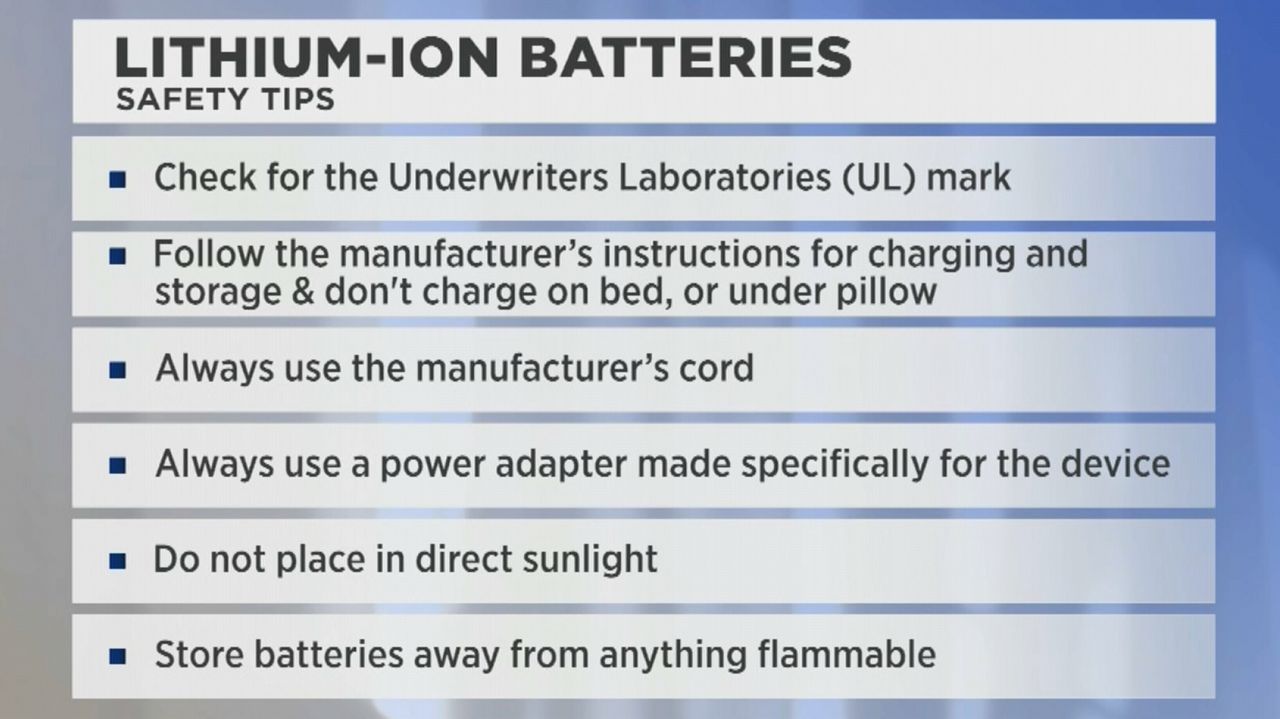Lithium-ion batteries have been in the headlines recently after causing many fires in the city.
Here are some answers to frequently asked questions about the common rechargeable power sources.
What are lithium-ion batteries and why are they dangerous when they are on fire?
A lithium-ion battery is “an advanced battery technology that uses lithium ions as a key component of its electrochemistry,” according to the Clean Energy Institute at the University of Washington. They are in many electric bikes and electric scooters. They are also in common items like laptops, tablets and phones.
The batteries have a tendency to overheat and can spontaneously combust when charging. The Clean Energy Institute says the batteries can also lose capacity and fail “after a number of years.”
According to New York City Fire Commissioner Laura Kavanagh, fires caused by lithium-ion batteries are “incredibly dangerous for citizens.”
“When they catch fire, they actually explode. So it is a very dangerous situation,” Kavanagh told NY1 in February.
Who uses lithium-ion batteries?
There are more than 65,000 app delivery workers in New York City who use e-bikes and e-scooters for their deliveries, according to the Hunter College New York City Food Policy Center.
Some city residents also use e-bikes and e-scooters to commute to work and for recreation.
How many fires have lithium-ion batteries caused in the city?
Fires involving lithium-ion batteries are on the rise in the city.
Lithium-ion batteries sparked 60 fires across the five boroughs between Jan. 1 and May 3 of 2022, according to the FDNY. City data shows it represents a 233% increase from the same period in 2021, which saw 18 fires between Jan. 1 and May 3.
The total number of fires involving lithium-ion batteries — plus deaths that followed as a result — from 2019 through this year is listed below. The data is courtesy of the FDNY.
- 2023 (as of May 1): 68 fires, five deaths
- 2022: 220 fires, 147 injuries, six deaths
- 2021: 104 fires, 79 injuries, four deaths
- 2020: 44 fires, 23 injuries, no deaths
- 2019: 30 fires, 13 injuries, no deaths
What are some examples of fires lithium-ion batteries have started in the city?
- A 7-year old boy and a 19-year-old girl died in a fire caused by a lithium-ion battery that erupted in April in Astoria. The victims did not have a chance to escape the building because an e-bike was stored near the front door, and an after-market charger and an extension cord were used to charge the device, according to FDNY officials.
- A lithium-ion battery sparked a fast-moving fire about 2 miles north of Yankee Stadium in the Bronx in March, leveling a supermarket and laundromat. The FDNY says that there were no fatalities, but seven people were hurt — five firefighters suffered minor injuries, while one civilian and one EMS worker had serious injuries.
- A fire tore through a building containing around 50 lithium-ion batteries in Bushwick, Brooklyn in February. Fire officials say that many of the batteries were left charging overnight, and they were not functioning properly. A woman was cirtically injured in the blaze.
- A fire in the Kew Gardens Hills neighborhood of Queens that erupted in January injured 18 children. The blaze broke out at a two-story residential house and occurred in the basement, which was used for two commercial businesses — a daycare and dental lab, according to the city's Department of Buildings.
- Videos posted to social media in November 2022 show firefighters using a rope in a dramatic rescue from a burning building in Turtle Bay. That Manhattan fire was caused by a lithium-ion a battery, and also led to at least 43 injuries, two of which were critical, according to the FDNY.
- A fire broke out in August 2022 on the sixth floor of an eight-story East Harlem apartment, killing a 36-year-old woman, a 5-year-old girl and three dogs. The FDNY said an e-bike or e-scooter's lithium-ion batteries sparked the deadly blaze.
- Five people were injured — three seriously — by a fire in a Bronx sixth-floor apartment in August 2022, firefighters said. A 28-year-old man in the house is a food delivery worker and uses an e-scooter to get around. He was charging the battery before the flames erupted, and fire officials said the battery sparked the fire.
- A fire in a Hell's Kitchen building — with a first-floor bike rental shop in it — injured one and forced people out of their homes in June 2022. The FDNY confirmed that there were "numerous" lithium-ion batteries found at the scene of the fire.
- Lithium-ion batteries caused a fire in May 2021 in a four-story apartment in Sunset Park. One store on the ground floor was an e-scooter repair business that stored batteries "contrary to the legal occupancy of the building," the city's buildings department said in a statement.
- One man died and a woman and two teenagers were injured in a fourth-floor fire in the East Village in December 2021. The FDNY said a lithium-ion battery from an e-bike caused the flames, which took firefighters about an hour to get under control.
What is being done about this issue?
The New York City Public Housing Authority was contemplating adding a rule in 2022 that would have banned e-bikes inside its 177,000 apartments across the city.
However, the rule was not approved after backlash from delivery workers and their advocates who claimed it would force them to quit their jobs.
"A lot of these fires that have occurred, for the most part, have been in private residences, and they have often, in some cases, been in a building where these were already banned. So we really feel the way towards making the city safer is to make sure that the regulation is there and that the education is there," Kavanagh said.
In March, Mayor Eric Adams signed off on a package of legislation that attempts to reduce the risk of fires caused by lithium-ion batteries. The laws will take effect in September.
One of the five bills will ban city businesses from selling, leasing and renting out new devices that do not meet industry safety standards. A second bill will ban manufacturers and businesses from assembling and selling batteries that contain cells from used devices, which are much more likely to malfunction. Other bills will require the FDNY to file reports compiling e-bike and e-scooter fire data and fire prevention recommendations, and also focus on public safety outreach.
There have been many City Council hearings in 2023 centered around lithium-ion battery fires, as lawmakers try to limit the amount of blazes that occur across the five boroughs.
"We are in a crisis mode right now when it comes to the batteries," City Councilman Keith Powers said at a Committee on Fire and Emergency Management hearing in April.
Are FDNY firefighters trained for fires involving lithium-ion batteries?
Yes. City firefighters are trained for fires involving lithium-ion batteries, according to Kavanagh.
“This is a part of their training. Now it is part of all of their materials to make sure that when they are responding to these fires, and encountering these batteries, that they are as safe as possible. So we do that every day,” Kavanagh said.
There are also products on the open market that could help people put out fires before firefighters even arrive. A lithium-battery incident kit, for example, has various extinguishing tools and safety gear, like a fire suppression pillow, fire blanket and high-heat gloves.
How should lithium-ion batteries be charged and stored?
The FDNY advises against charging a lithium-ion battery under a pillow, on a bed, near a door or on a couch. They also suggest using the manufacturer’s cord and power adapter made specifically for the device. When charging, batteries should never be left unattended.
Batteries should be kept at room temperature and away from direct sunlight, according to the FDNY. They should not be near anything flammable.
Finally, if a battery overheats, emits an odor, changes shape or color, leaks, makes noises, the FDNY instructs that one should call 911.

How should lithium-ion batteries be disposed?
It is illegal to put lithium-ion batteries in the trash or recycling, according to the city.
The batteries can be taken to a Special Waste Disposal site or a store that sells rechargeable batteries or products containing them, the city said. Laws require all state stores selling rechargeable batteries or products containing them to accept rechargeable batteries for recycling.
“They are very toxic and so, for the sake of the first responders and those disposing of them, we have to make sure they are disposed of properly,” Kavanagh said.
Where can I find more information?
The FDNY has an informational flyer with safety tips for lithium-ion batteries. It can be downloaded by clicking here.








_Pkg_NYPD_Cop_NJ_Shooting_Clean_131152335_3440)

